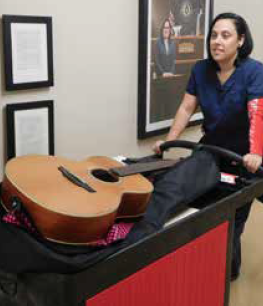 When Eileen McKissick began offering sound therapy in her massage practice, she soon discovered she could use tuning forks to locate and hear disturbances in the energy field, or biofield, that surrounded each of her clients.
When Eileen McKissick began offering sound therapy in her massage practice, she soon discovered she could use tuning forks to locate and hear disturbances in the energy field, or biofield, that surrounded each of her clients.
She found these energetic disturbances correlated with the emotional and physical traumas her clients had experienced throughout their lives, with the biofield acting as a record of pain, stress, and trauma from gestation onward. Passing the forks through these areas in the biofield not only corrected the distorted vibrational sounds she was hearing, but also imparted consistent, predictable, and sometimes immediate relief from pain, anxiety, and insomnia.
Tuning: Health and Wellbeing
Violinists and violists have the unique experience of hearing intervals of (we hope) perfect fifths right next to both ears, and therefore they absorb any acoustic/vibrational rewards that have been attributed to the healing qualities found in the perfect fifth (as well as other perfect intervals).
Respected physicians and researchers within the elite community of medicine have officially found and established adequate merit with the branches of healing concerned with sonic therapies. I find myself wondering: does the unskilled tuning of double stops in open intervals consequently have any negative impact on one’s health?
The “Other“ Solution
Have you ever worried that someone might notice (during orchestra tuning) that you can’t distinguish the perfect interval central to your instrument? I dare say that many truly talented and professional string players are not born with the relatively rare gift known as “perfect pitch.” Most musicians learn “relative pitch” and hone their abilities to recognize sensation – the vibrational uniqueness when a moving peg slides the string into that perfect interval. It hums with “rightness.”
Many violinists and violists are insecure enough to arrange any active tuning to be private; to hone the instrument into a state of pitch that is just approximate enough that the pegs never require you to be “the last man tuning.”
Instead, the musician will inevitably need to make minute compensating adjustments of intonations the entire rehearsal or concert to enhance the ensemble’s sound quality. This Is something we ought to be doing anyway as a natural extension of the way we control our sound and play with intention. It is a substitution – an intentional misdirection meant for those colleagues who inevitably deliver judgements.
As students, we are afforded guidance in how to manage the difficulties presented us by the instrument. Someone tells us when we are (or are not) rightly tuning our open strings via pegs and/or fine tuners.
As we assume more and more of that responsibility ourselves, there certainly are legitimate functional issues from time to time requiring repair or the attention of a professional luthier. Often in professional capacity, we tune twice. First, we tune with the tuner and then we go back over the strings using double-stops to determine the fifths sound as they should. Cellists use harmonics, but I have never felt the benefit of harmonics while tuning a violin or viola.
It is frustrating to be dependent upon the digital tuner, as there are some serious flaws to be aware of. For example, it doesn’t take much for the buttons that calibrate the location of the pitch to get depressed accidentally in a book bag or case pocket.
Additionally, they are digital. They are made to assume equidistant interval spacing between any given note. Hopefully ensemble-serious string players understand the nature of how the intervals on other instruments behave (ie, keyed instruments) differ from our own). This affects the requirements of our intonation to make the ensemble and performance sound right. But, there is a tuning aid that is natural and accurate: the “tuning fork.” However, it isn’t very practical to use inactive tuning that requires the use of both hands.
The Tuning Fork and Other Sonic Therapies
A week or so ago, I was playing around with two tuning forks I have. I was thinking it would be cool to record them together as pedal tones or drones for a song, and I was contemplating how one could do so successfully. Absently, I gave each a good bang to an elbow. I listened in opposing ears simultaneously to the interval they created.
Naturally, it wasn’t long before I was trying out theories on my three cats. Little did I know, it is actually a real thing! When I looked online, the first thing I saw was a standard picture of the patient laying on the table with the therapist holding a tuning fork on either side of their ears as I’d just done.
Interesting Current Research Regarding Elements of Music:
Tuning fork therapy
Binaural beats
Singing bowl therapy (12th century Tibetan ritual)
Vibroacoustic therapy

















